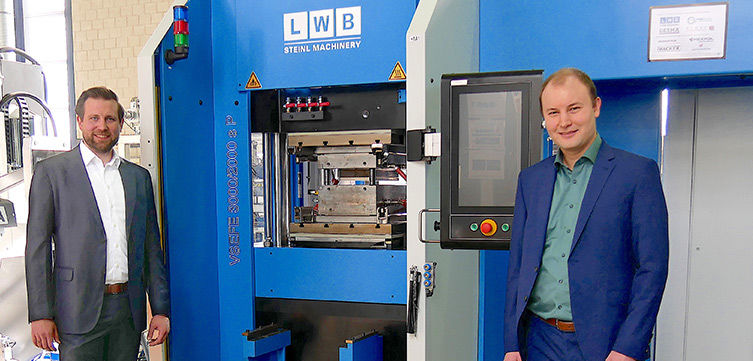The German elastomer injection molding machine manufacturer LWB Steinl with headquarters in Altdorf / Landshut continues the long-term cooperation with the rubber technology department at IKV-Aachen. As part of this collaboration, the machinery used in research and teaching is updated at regular intervals. In this year, the renewal of the machine technology was dominated by the expanded possibilities for process intelligence through the new "Flex-Evo" machine control. It is the central innovation of the new version of the injection molding machine of the type VSEFE 3000 / 2000s P with 3000 kN tie bar clamping unit, 2000 cm3 max. injection volume, servo-drive system, EFE injection system, cascade control for nozzle control of cold runners and extensive demolding functions.

Dr.-Ing. Martin Facklam, head of the IKV extrusion and rubber technology department (left) and Clemens Wiesel, M.Sc., research associate in the elastomer injection molding work group with the new machine made available by LWB-Steinl for laboratory and training operations.
The Institute for Plastics Processing (IKV) in Industry and Crafts at RWTH Aachen University, founded in 1950, currently has around 290 industrial partners and is Europe's leading research and training institute in the field of plastics technology. As a result, teaching is accompanied by a practice-oriented research company. This offers industrial companies the opportunity to make use of qualified services or to work with the institute and offers students the attractiveness of an education that is up to date. In total, more than 300 people research, teach and learn on a total area of around 9,000 m2.
An important part of the IKV is the department for elastomer injection molding, in which 4-5 student theses (project, bachelor and master theses) are written per year, as well as dissertations over a longer period of 4 to 5 years. In addition, several publications are published annually in specialist and scientific journals.
The cooperation between the Bavarian elastomer machine builder LWB-Steinl and the IKV has a long tradition and goes back several years and is supported by the provision of injection molding machines and the necessary operational know-how. LWB sales manager Peter Radosai says: “The newly provided machine of the type VSEFE 3000 / 2000s P will primarily be used in scientific test operations, which brings us into contact with new process variants and application possibilities, which in turn flow into the machine development."
For example, the current change in the vehicle industry from combustion- to electric and hydrogen vehicles is shifting the requirements placed on elastic components. In this context lightweight construction potential or media resistance to de-ionized water etc. are given new or increased priority.
The focus of the work area elastomer injection molding is currently in particular on the process-integrated detection of batch fluctuations with the help of a new online rheometer, which opens up new possibilities in quality assurance, as the IKV department head for rubber technology, Dr.-Ing. Martin Facklam reports (Fig. 2).
The production of media lines from carbon-black rubber compounds, which has been pursued for a number of years, is also being promoted. The projectile injection technique known from thermoplastic injection molding forms the starting point of the research work. Meanwhile it is now possible to produce moldings with complex cavity geometries as well as integrated functional elements.
Another important research area is the reduction of the component weight through intelligent use of the property and processing spectrum of new types of elastomer materials.
The interdisciplinary cooperation between the IKV-rubber researchers and industrial partners will develop synergies from material preparation to topology-optimized component design (note: the topology-optimized component design is a computer-based calculation method that determines a favorable basic shape (topology) for components under mechanical stress). Last but not least, this will also open up new possibilities for elastomeric lightweight construction applications.
The injection molding machine technology from LWB Steinl, which is flexibly used in practical research, enables young engineers to gain valuable practical experience beyond the scientific test operation and to deepen the theoretical knowledge acquired in university teaching and to participate in answering current research questions.
Technical Details
Peter Radosai – Sales manager Europa
E-mail: peter.radosai@lwb.de.com
Press Contact
Christina Lebeus – Marketing
E-Mail: christina.maniera@lwb.de.com
Author:
Reinhard Bauer – TECHNOKOMM
E-Mail: office@technokomm.at